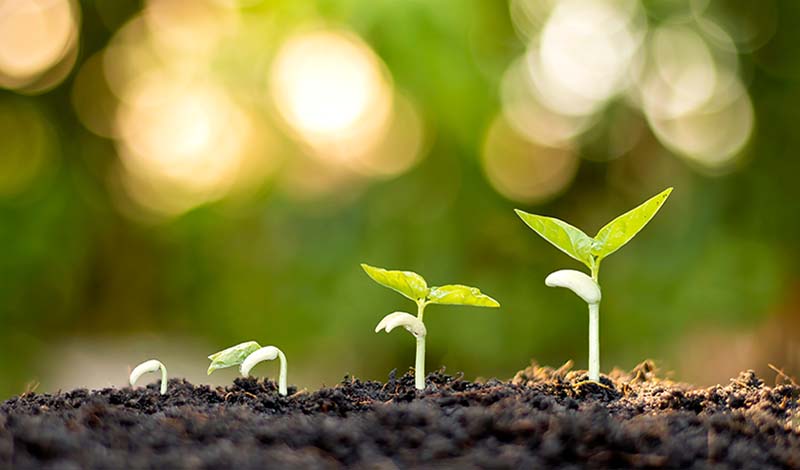2.5-minute read
It’s the little things citizens do.
That’s what will
make the difference.
My little thing is planting trees.
Wangari Maathai
If you’re a regular reader, you know we’re big on trees—planting them, protecting them, and writing about them. In honor of Earth Month, we’d like to share a bit about how our planting partners at Tree-Nation do that planet-preserving thing they do—helping tackle the urgent mission of restoring the world’s forests.
Capturing carbon, protecting biodiversity, and supporting the livelihoods of local communities through reforestation are all at the top of the planetary to-do list. While tree planting seems simple enough—just dig and drop—the most successful reforestation strategies combine scientific and indigenous knowledge to create customized planting techniques that result in the greatest all-around benefits for people, wildlife, and the planet. To overcome the increasing global environmental challenges that impact survival rates, the right trees must be planted in the right place in the right way.
So how does Tree-Nation ensure that newly planted seeds and seedlings fulfill their tree-life destiny to combat climate change, purify the air and water, and provide revenue, food, fodder, and medicine for local populations and habitats for millions of species? They think globally and plant locally, using a variety of methods that align with the Ten Golden Rules of Reforestation, guidelines developed by an expert team of researchers at the Royal Botanic Gardens to help avoid the pitfalls of large-scale tree-planting initiatives.
Wherever they plant in the world, the number one objective of every project that Tree-Nation supports is to encourage a diverse mix of native tree species that minimize harm and maximize long-term benefits.
From simple methods that simulate animal dispersal to highly engineered solutions like drones, for all the forestry nerds out there, this is how Tree-Nation digs, drops, and re-trees to meet their commitment of a trillion trees planted by 2050:
Direct Sowing
Planting individual seeds directly into the soil where the trees are to be established.
Benefits: Trees grow strong and adapt well to their environment.
Muvuca Strategy
Spreading seeds of hundreds of varieties of native species over every square meter of land. You can learn how this technique is being used to save forests in Brazil here.
Benefits: Creates natural spread of vegetation and dense forests.
Seed Bombs
One or multiple seeds are wrapped in clay and compost, protecting the seed from harsh weather and animals.
Benefits: Easy to manipulate and quick to plant.
Aerial Seeding
Sowing seeds by dropping them from a drone, plane, or helicopter to disperse seeds into difficult-to-reach locations.
Benefits: Offers a cheap automated method to plant at a large scale.
Nursery Seedling Transplant
The most widespread technique in tree planting, seedlings spend 3-6 months in nurseries before being transplanted, usually during the rainy season.
Benefits: Offers great control over quantities and species planted and survival rate.
Assisted Natural Regeneration
Protecting and preserving natural tree seedlings in forested areas by employing different techniques to remove or reduce barriers.
Benefits: A natural approach that is inexpensive and well-suited to existing forested areas.
If you’d like to learn how effective restoration organizations like Tree-Nation determine which trees should be planted where check out the GlobalTreeSearch for a list of every known tree species on Earth by country.
A final thought on reforestation—as enthusiastic as Favorite World Press is about tree planting, and that would be a 10 out of 10, we want to emphasize that to maintain the healthy functioning of our planet protecting existing old-growth forests like Alaska’s Tongass is essential.
And a gentle reminder—we plant one tree for every print or e-book sold. If you’d like to make tree-planting your little thing, read with us!

ICYMI Nature News
Crying Plants
According to new research published in Cell, thirsty plants make ultra-sonic noise that can be heard by some animals. This is what it sounds like when plants cry.
Introverted Tigers
Do you think all Siberian tigers have big cat energy? Scientists have identified two distinct personality types in the stripey felines that map to the traits of introversion and extroversion in humans. Either way, we think they’re grrrrrreat!
Glow-In-the-Dark Garden Mice
Platypus do it, some squirrels and hares do it, and according to Estonian researchers, garden dormice do it. What’s that? They glow under UV light. Rodential party animals.
Self-Aware Bees
Pollination ecologist Stephen Buchmann has published new research that indicates bees are sentient and may have a primitive form of consciousness. We knew it all along.
DIY Elephants
According to a new study, elephants may be one of the few species on Earth to have domesticated themselves. If you want something done right do it your ele-self.
FWP Carbon Capture Report
From April 2022 through March 2023, the trees we’ve planted across 12 projects bring our carbon capture total to 3157 tons of CO2. That’s equivalent to 8,093,790 miles driven by an average gasoline-powered passenger vehicle, 136,664 trash bags of waste recycled instead of landfilled, or 3,536,616 pounds of coal burned.































































